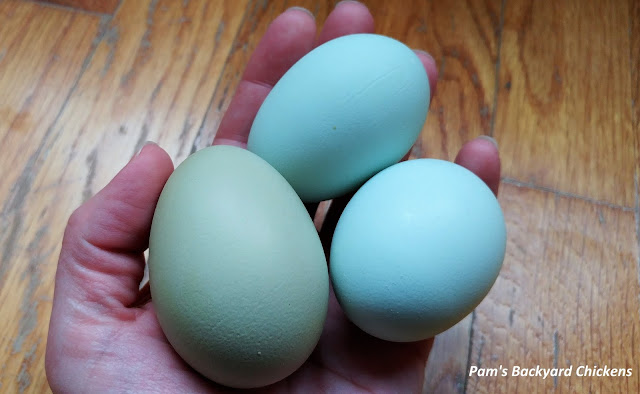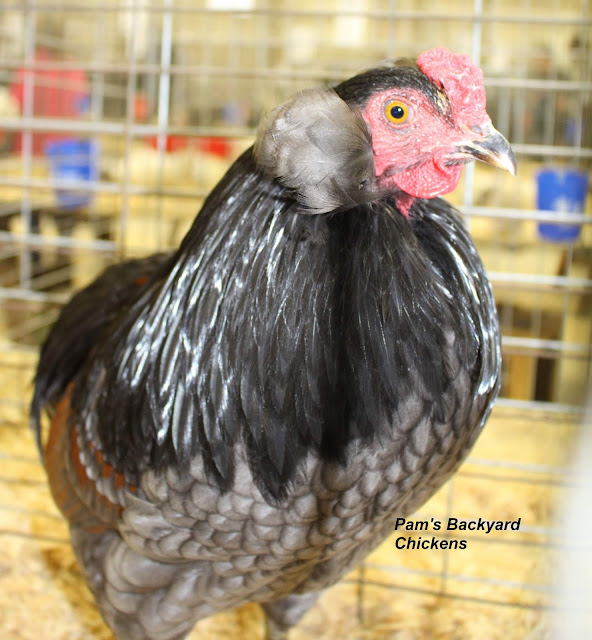Blue & Green Egg Myths
Do blue eggs taste different than "regular" eggs? No.
Do blue eggs contain more or less cholesterol than eggs of other colors? No.
Here's why — the quality of an egg's nutrition and an egg's taste is determined by diet.
All eggs are formed in the same way, but the nutrition a hen gets on a daily basis is what gives her egg its taste and gives the yolk its color. If your backyard chickens are fed a quality layer feed and allowed to forage for grasses, insects and anything else they can find, you can be assured your eggs will be fresh and taste good.
 |
| Easter Egger and Cream Legbar Eggs |
How Blue Eggs Get Their Color
Once a hen ovulates and a mature yolk is released to form a complete egg, the total process takes about 25 hours. About five hours into the process, the forming egg moves into the shell gland where it spends the next 20 hours with the shell being formed around the inner contents.
All eggs start out white because they are formed of calcium carbonate. If you have a white egg laying chicken, like a Brown Leghorn, then no additional pigment is added to the egg. If you have a blue egg laying chicken, the blue pigment, oocyanin (a by-product of bile formation), is added after the white shell is formed and it sinks through the entire shell.
How Brown and Green Eggs Get Their Color
Brown eggs, like those laid by a New Hampshire chicken or Brahma chicken, get their color from a pigment called protoporphyrin. This color is applied fairly late in the shell-forming process and does not sink through the outside of the shell. So, if you open a brown egg, you’ll see the inside of the shell is white.
Fun Fact: Recent research suggests bits of this pigment is found in every layer of calcium in the shell. But those bits of pigment do not influence overall shell color.
Green or olive eggs are a little more complicated. First, the blue pigment is applied, followed by the brown pigment. The pigments mix on the surface to form a solid green color. The darker the brown, the deeper the green color. The green does not sink completely through the shell, so green eggs are blue on the inside of the shell.
Pin the image below to save this information for later.
Blue and Green Egg Laying Chickens
When talking about chicken breeds it’s important to understand the difference between breeds and hybrids. A breed is a group of animals that have the same characteristic and predictably reproduce that characteristic when bred to together. A hybrid is made of a mix of breeds. There are two breeds in the blue egg laying world currently accepted by the American Poultry Association — Araucanas and Ameraucanas.
Araucana Chicken
Araucanas are distinct chickens. They are rumpless — without the profusion of feathers on their back end — and it’s hard to miss the distinguishing tufts of feathers sticking straight out on both sides of the neck. These feathers can take different shapes and sizes and form curls, balls, rosettes, and fans.
Araucanas were created from imports from South America to the United States in the 1930s. These imports were a cross between two Northern Chilean breeds, the Colloncas (a rumpless blue egg layer) and the Quetros (a chicken with tufts and a tail but not a blue egg layer). The first imports paved the way for breeding that led to two distinct breeds — the Araucana and the Ameraucana.
In the Araucana, the gene for blue egg color is dominant. This means that when an Araucana is bred with another breed of chicken, the offspring will produce blue or tinted eggs. The Araucana is a difficult-to-find breed that often only comes from specialized breeders. Araucanas are friendly birds that do fly easily, so accommodations should be made to keep them safe.
Ameraucana Chicken
Easter Egger Chicken
This is the bird you’ll most often find in hatchery catalogs as a blue egg layer. Some hatcheries accurately call their stock by the Easter Egger name. Others call their stock Araucana, Ameraucana, or Americana.
This is a hybrid bird that lays blue, green, rose or even brown eggs. It’s impossible to know what color egg your Easter Egger will lay until it lays its first egg. Although the name refers to a holiday basket of colored eggs, your Easter Egger will not lay different colored eggs each time it lays an egg. Whatever color egg it lays first is the color it will continue to lay for a lifetime.
Olive Egger Chicken
Olive Eggers are beginning to build in popularity as they lay a darker green egg rather than a pastel. Olive Eggers are a hybrid chicken that can come from a variety of breeding combinations. Most hatcheries use Marans (dark brown egg layer), Ameraucanas, Welsummers (dark brown egg layer), and Cream Legbars in their pairings.
Crossing a brown egg layer with a blue egg layer can result in an olive green egg. And depending on the depth of the brown egg layer used, the deeper the olive color. Like the Easter Egger, Olive Eggers come in many different feather color combinations. Some can have crests, some can have feathered legs, some have pea combs, and others have single combs.
Cream Legbar Chicken
This is a relatively new addition to the blue egg laying scene in the United States. Cream Legbars are not currently recognized by the American Poultry Association.
Cream Legbars were created by R.C. Punnet, a renowned geneticist, in the United Kingdom in the 1930s. These are unusual birds that have a single comb followed with crest feathers. Some say their crest feathers look like they’re wearing a beret. They are friendly birds that love to free-range and forage.
What makes Cream Legbars special is they are an autosexing breed so males and females can be determined by color at hatch. This makes owning Cream Legbars a nice way to add colored eggs to your flock without the risk of getting a rooster if you don’t want one.
Pin the image below to save this information for later.
Blue and Green Egg Laying Chickens
When talking about chicken breeds it’s important to understand the difference between breeds and hybrids. A breed is a group of animals that have the same characteristic and predictably reproduce that characteristic when bred to together. A hybrid is made of a mix of breeds. There are two breeds in the blue egg laying world currently accepted by the American Poultry Association — Araucanas and Ameraucanas.
Araucana Chicken
Araucanas are distinct chickens. They are rumpless — without the profusion of feathers on their back end — and it’s hard to miss the distinguishing tufts of feathers sticking straight out on both sides of the neck. These feathers can take different shapes and sizes and form curls, balls, rosettes, and fans.
Araucanas were created from imports from South America to the United States in the 1930s. These imports were a cross between two Northern Chilean breeds, the Colloncas (a rumpless blue egg layer) and the Quetros (a chicken with tufts and a tail but not a blue egg layer). The first imports paved the way for breeding that led to two distinct breeds — the Araucana and the Ameraucana.
In the Araucana, the gene for blue egg color is dominant. This means that when an Araucana is bred with another breed of chicken, the offspring will produce blue or tinted eggs. The Araucana is a difficult-to-find breed that often only comes from specialized breeders. Araucanas are friendly birds that do fly easily, so accommodations should be made to keep them safe.
Ameraucana Chicken
The Ameraucana chicken's origins are recent and straightforward. This breed is directly linked with the Araucanas that were imported in the 1930s. Ameraucanas were developed in the 1970s by breeders that liked the blue or tinted eggs of the Araucana but wanted closer head feathering and a plump, well-feathered body. Ameraucanas were admitted to the American Poultry Association’s Standard in 1984. This is a dual-purpose breed that can be used for both meat and eggs. Unlike the Araucana, Ameraucanas have a tail and they have muffs and beards, not tufts.
Easter Egger Chicken
This is the bird you’ll most often find in hatchery catalogs as a blue egg layer. Some hatcheries accurately call their stock by the Easter Egger name. Others call their stock Araucana, Ameraucana, or Americana.
This is a hybrid bird that lays blue, green, rose or even brown eggs. It’s impossible to know what color egg your Easter Egger will lay until it lays its first egg. Although the name refers to a holiday basket of colored eggs, your Easter Egger will not lay different colored eggs each time it lays an egg. Whatever color egg it lays first is the color it will continue to lay for a lifetime.
Olive Eggers are beginning to build in popularity as they lay a darker green egg rather than a pastel. Olive Eggers are a hybrid chicken that can come from a variety of breeding combinations. Most hatcheries use Marans (dark brown egg layer), Ameraucanas, Welsummers (dark brown egg layer), and Cream Legbars in their pairings.
Crossing a brown egg layer with a blue egg layer can result in an olive green egg. And depending on the depth of the brown egg layer used, the deeper the olive color. Like the Easter Egger, Olive Eggers come in many different feather color combinations. Some can have crests, some can have feathered legs, some have pea combs, and others have single combs.
Cream Legbar Chicken
This is a relatively new addition to the blue egg laying scene in the United States. Cream Legbars are not currently recognized by the American Poultry Association.
Cream Legbars were created by R.C. Punnet, a renowned geneticist, in the United Kingdom in the 1930s. These are unusual birds that have a single comb followed with crest feathers. Some say their crest feathers look like they’re wearing a beret. They are friendly birds that love to free-range and forage.
What makes Cream Legbars special is they are an autosexing breed so males and females can be determined by color at hatch. This makes owning Cream Legbars a nice way to add colored eggs to your flock without the risk of getting a rooster if you don’t want one.
Do you have any of these birds in your flock? What are your favorite blue egg layers?





we got an egg from a friend and want to keep it alive HELP
ReplyDeleteIf you know that it is a fertile egg, then you can purchase an incubator and hatch the egg. Brinsea has some wonderful incubators. It's usually best to hatch more than one chicken at a time since chickens are social creatures. If you can add a few more eggs to your clutch, that would be perfect. Hope this helps!
Delete